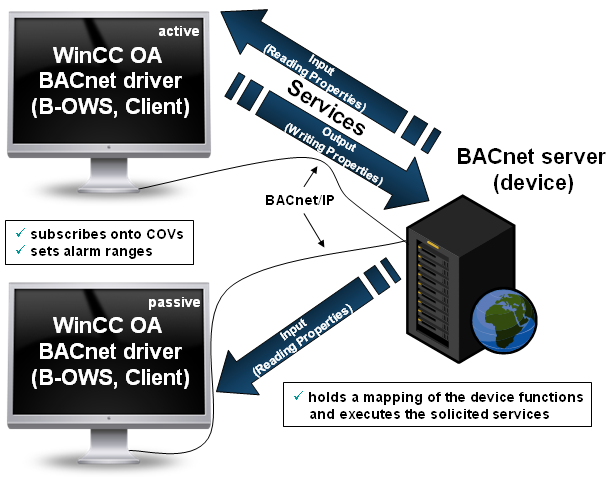BACnet Driver
BACnet (Building Automation and Control Networks) is a normed protocol for building automation and was designed by ASHRAE (American Society of Heating, Refrigerating and Air-Conditioning Engineers) in order to provide a consistent and intraoperative standard for data communication in and with systems of building automation.
The purpose of the standardization is the interoperability (collaboration of products and applications of unequal manufacturers). For the definition of the applied BACnet devices BIBBs (BACnet Interoperability Building Blocks) are used, which are a collection of several BACnet services.
The WinCC OA BACnet driver assumes the BACnet Operator Workstation (B-OWS) role. The WinCC OA BACnet driver uses the services of the BACnet server.
The browsing for BACnet devices and objects and the creation in WinCC OA takes place with the aid of the WinCC OA BACnet HMI. The WinCC OA BACnet Object Library provides the configuration and visualization of BACnet devices and objects in WinCC OA. For further information see BACnet Application.
For the use of the BACnet driver, WinCC OA BACnet HMI as well as the WinCC OA BACnet Object Library are not mandatory, due to the fact that the BACnet driver can be used as a WinCC OA default driver and therefore needs no special project structure.

Mapping BACnet <-> WinCC OA
The BACnet driver maps BACnet properties to datapoint elements by using the peripheral address. So a defined data structure is not required.
The following mappings are expedient from the application view:
- BACnet object <-> WinCC OA datapoint type
- BACnet object instance <-> WinCC OA datapoint
- BACnet property <-> WinCC OA datapoint element (gets the BACnet peripheral address)
BACnet Objects
BACnet models different technological devices (e.g. motor) of the building automation application as a collection of objects.
Objects are divided into three classes
- simple objects
- complex objects
- device objects
For a list with all supported objects see chapter BACnet Object Types.
BACnet Services
The data (properties and objects) are transmitted to the user by services. The needed services are divided into five application classes:
- Object Access Services
- Alarm and Event Services
- Device and Network Management
- File Access Services
- Virtual Terminal Services
Services can be either confirmed or unconfirmed:
- confirmed - expects a response
- unconfirmed - does not expect a response
The services are transmitted via the client/server principle. WinCC OA acts as client and the BACnet device acts as server.
The client provides the management and operation station (B-OWS - BACnet Operator Workstation).
In order to guarantee the interoperability of the devices, the services are additionally divided into several interoperability sections, e.g.:
- Alarm and Event Services
- Data Sharing
- Scheduling
- Device and Network Management
For information about the supported BIBBs per service see chapter BACnet Interoperability Building Blocks.
User Interface
The UI of the BACnet driver is composed of the configuration panel and the peripheral address panel.
Interface
The transmission of data between sender and receiver takes place over:
- BACnet/IP
BACnet certification
The WinCC OA 3.15 BACnet driver was certified in conformance with BACnet standard ISO 16484-5 protocol revision 1.14 (refer to the PICS document PICS document - BACnet International).
The WinCC OA 3.20 BACnet driver was certified in conformance with BACnet standard ISO 16484-5 protocol revision 1.19 (refer to the BACnet Protocol Implementation Conformance Statement).
Chapter Overview
| Chapter | Description | |
| BACnet Driver, basics | General information on the BACnet driver (BIBBs, services, objects, properties, engineering, UI, interface and redundancy). | |
| Requirements and Installation | Requirements and installation of the BACnet driver. | |
| BACnet Interoperability Building Blocks | Table with the supported BIBBs. | |
| BACnet Object Types | Table with the supported object types. | |
| BACnet driver config file | Config file with the mandatory "net" entry for data transfer. | |
| Configuration of the BACnet Driver | Configuration panel of the BACnet driver. | |
| Definition of the peripheral addresses of the BACnet driver | Description of defining the peripheral address for the BACnet driver. | |
| Redundancy and Debug Flags | Information on the requirements for a redundant operation and possible debug flags. | |
| Internal datapoints of the BACnet driver | Structure and description of the internal datapoints _Bacnet and _BacnetDevice. | |
| Possible Config Entries of the BACnet Driver | Description of the optional BACnet driver config entries. | |
| Example for the BACnet Driver | Example for buildup of the communication. | |
| Details of the BACnet driver | ||
| Command Priority | Description of the two components of the priority mechanism. | |
| Intrinsic and Algorithmic Reporting | Description of the mechanisms for the creation of alarms and events. | |
| Limited COV Registrations | Approach in case of a limited number of COV registrations. | |
| BACnet Data Types | BACnet data types of the supported object properties and their counter pieces in WinCC OA. | |
| Summary and relevant Links | Other relevant chapters in the Online Help. | |
